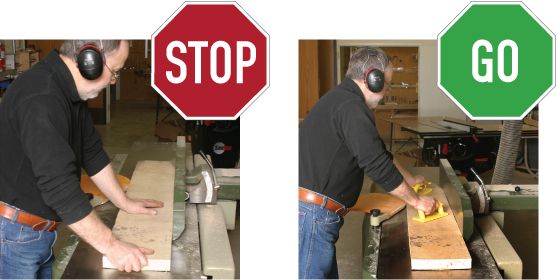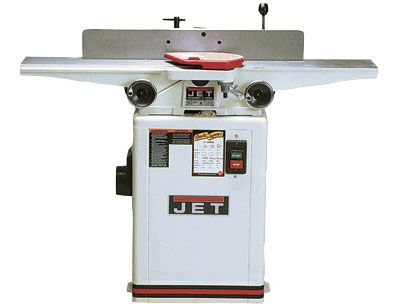Safety Manual for the Jointer
A list of safety precautions to use when operating a jointer in your shop.

Wrong Way, Right Way: Use paddles to protect your hands as you push the workpiece through the jointer. And make sure the blade cover is working properly.
The jointer does one important thing very well. It creates a perfectly flat surface, either on the face of a board, or on the edge (with the face of the board riding against the jointer’s fence). When milling rough lumber, the jointer represents the first step, producing one flat face and one straight edge for reference. The board then moves to the planer for thicknessing and the tablesaw to be cut to final width.
To work properly the outfeed table should be set at the exact same height as the blades. The position of the infeed table determines the depth of cut, and multiple passes can be taken to produce a completely flattened surface.
The following is a list of safety precautions to take into account when operating a jointer.
1. Always read and follow the manufacturer’s instructions.
2. Wear ear and eye protection, and do not wear jewelry, long sleeves, or loose clothing.
3. Use paddles, push blocks, and push sticks to keep your hands 6 in. away from from the cutterhead at all times.
4. Never joint stock less than 12 in. long.
5. Check the depth of cut before turning machine on.
7. Never edge joint material less than 1/4 in. thick, 3/4 in. wide or 12 in. long.6. Adjust depth of cut to less than 1/32 in. for material with knots, 1/16 in. for clear material.
8. Never face joint material less than 3/8 in. thick, 3/4 in. wide or 12 in. long.
9. Keep knives sharp and the machine adjusted properly.
10. Always have the blade guard in place.
11. Stand to one side of the jointer, not directly behind it.
12. Allow the cutterhead to reach full speed before starting a cut.
13. Keep your eyes and undivided attention on the machine while using it.
14. Never feed material with your thumb or fingers on the end of it; keep them on top of the material.









Comments
What I don't like in jointers is that a bad technique often looks like simply mechanical problem. When you establish it's not your technique that's causing the problem, well there's that. Fixes of mechanical issues are often related to extreme precision and not always successful. When the jointer's fine, it can be very VERY helpful though.
Strange that the list from Fine Woodworking jointer safety does not mention to inspect the wood you are jointing for loose knots and other defects!
Loose knots, pitch hollows and other defects are one of the most common causes of kickbacks!
The list also does not mention to keep people away from the area behind the jointer !
Jim Berns
Also check for nails and staples. Buy a cheap metal detector wand on Amazon. They work great for finding nails.......
I had a young man hook his fingers over the rear edge of a board at the jointer in 1980; the ER called and asked if the tips of the three fingers could be retrieved. The guys drew lots to see who would dig thru the chips; he made the end of his fingers a flat plane that day.
Log in or create an account to post a comment.
Sign up Log in